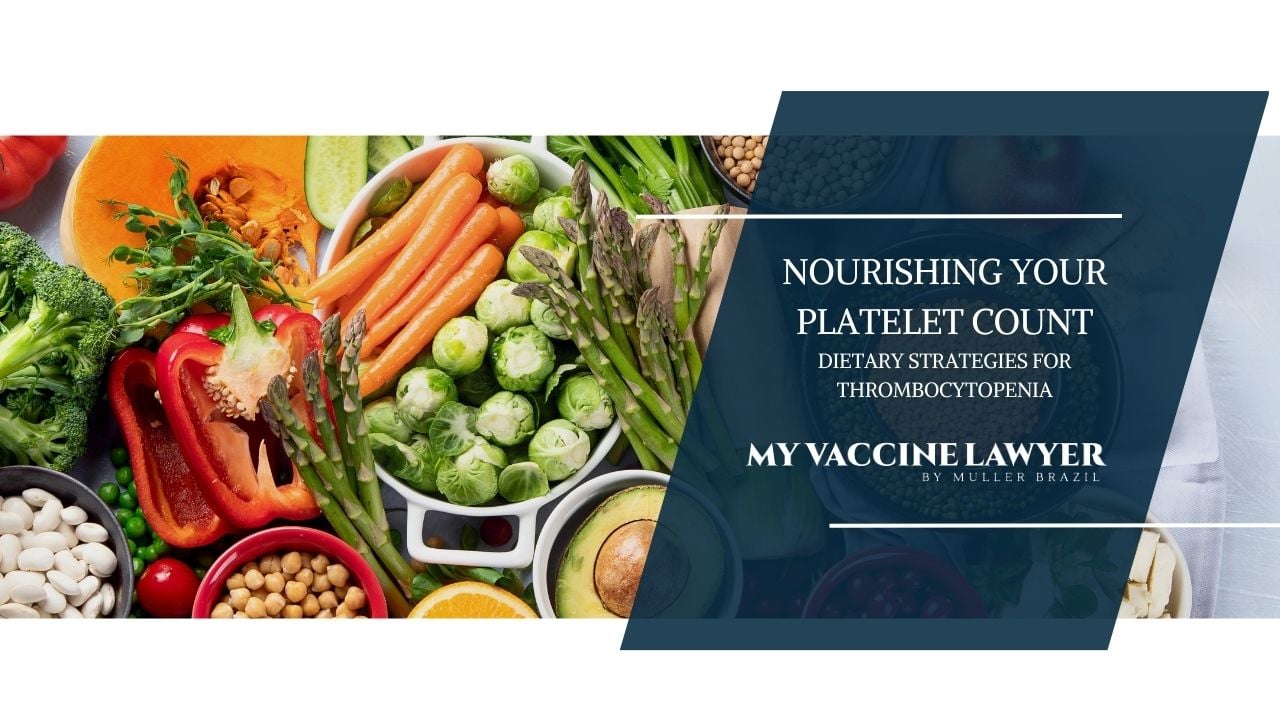Varivax Vaccine Guide: Chickenpox Prevention & Safety
The vaccine works by introducing a weakened form of the virus, helping your body build immunity without causing the illness. Given in two doses, it...
8 min read
Vaccine Injury Law Resources / Immune Thrombocytopenic Purpura / Thrombocytopenia Diet: Essential Foods for Platelet Production
 Max Muller
:
Feb 15, 2024 5:36:00 PM
Max Muller
:
Feb 15, 2024 5:36:00 PM
According to a study published in the American Journal of Clinical Nutrition, diet plays a significant role in the management of thrombocytopenia.
If you're dealing with thrombocytopenia, which means you have low platelet counts, choosing the right foods can really help. Eating foods like papaya, kiwi, collard greens, red meat, and lentils is beneficial because they're full of important vitamins and minerals like iron, Vitamin K, B12, and C. These nutrients help increase your platelets. It’s also important to avoid alcohol and foods high in unhealthy fats, as these can lower your platelet levels. By focusing on a balanced diet, you can boost your overall health and better manage your condition.
When dealing with thrombocytopenia, every bite counts. A diet rich in specific nutrients is recommended by the platelet disorder support association to increase platelet production and function. Foods like papaya, kiwi, collard greens, dark chocolate, and those high in vitamin C can help increase platelet counts. Iron-rich foods like red meat, poultry, seafood, lentils, and beans are also crucial in platelet production.
While what you add to your plate matters, what you take away is equally important. Processed foods can have a negative impact on platelet count and overall health. So, the next time you reach for that bag of chips, remember that you’re not just risking your waistline but potentially your platelet count too.
Thrombocytopenia is a medical condition characterized by a low blood platelet count. This can be problematic as platelets are crucial in blood clotting. When the platelet count is low, it could result in excessive bleeding even from minor injuries, and in severe cases, spontaneous bleeding can occur.
Thus, it's essential for individuals with thrombocytopenia to follow a diet that supports platelet production, helping to increase the platelet count and reduce the risk of bleeding complications.,
Certain foods can positively or negatively impact platelet count, making it essential for individuals with thrombocytopenia to follow a diet that supports platelet production. The food you consume can either be your greatest ally or your worst enemy.
.jpg?width=2240&height=1260&name=MVL%20template%20(6).jpg)
A healthy diet rich in fresh, whole foods such as:
can significantly benefit individuals with thrombocytopenia. However, excessive consumption of certain healthy foods may interfere with clotting, hence the need for moderation.
Nutritional deficiencies, such as those of vitamin B12, copper, and vitamin C, can lead to a low platelet count. This means that if you aren’t getting enough of these essential nutrients, your platelet production may be taking a hit. The Platelet Disorders Support Association recommends a balanced diet rich in vitamins and minerals to help maintain healthy platelet levels.
Research has indicated several dietary factors that can support platelet function and maintain platelet counts within the normal range. Dietary bioactive compounds, for instance, are substances in foods that can affect biological processes or substrates and influence health. These compounds, found in a variety of fruits and vegetables, can positively impact platelet function.
The Mediterranean diet is another dietary strategy that can be beneficial. This diet emphasizes fruits, vegetables, whole grains, and healthy fats, and it has been associated with maintaining healthy platelet counts.
Furthermore, specific vitamins have been shown to contribute to platelet health. Vitamins such as B12, C, and K, when consumed in adequate amounts, can support platelet production and function.
However, while these dietary components can be beneficial, avoiding unhealthy ones is vital. Trans fats, for example, can negatively impact platelet function and overall health. These unhealthy fats are often found in processed foods and should be limited to a healthy diet.
Your platelet count has a few powerful allies, and they are readily available in your kitchen. Iron and Vitamin K are two nutritional allies that can help your body produce more platelets and improve their function.
Iron supports platelet synthesis and helps in energy production within platelet mitochondria, which in turn leads to increased platelet counts and volume. On the other hand, Vitamin K helps clotting, making sure that your body can effectively stop bleeding when necessary.
We will now look at the specifics of these two nutritional superheroes.
Iron is the building block of healthy blood cells. It is important in the production of hemoglobin, a vital protein in red blood cells responsible for oxygen transport in the body. Including iron-rich foods in your diet can, therefore, help manage thrombocytopenia, as iron is indispensable for the generation of healthy blood cells.
Iron-rich foods that support platelet production and boost the immune system include:
When planning your next meal, consider including some of these iron-rich foods.
Vitamin K is another important nutrient for those with thrombocytopenia. To get an adequate amount of Vitamin K in your diet, aim to include green leafy vegetables, natto (fermented soy), scallions, kiwi, and animal sources like liver and meat.
Keep in mind that it’s about more than just eating right; it’s also about making informed dietary choices. Understanding the role of different nutrients in your body helps you make more informed food choices and manage thrombocytopenia more effectively.
While some foods help increase your platelet count, there are also foods and drinks that negatively impact it. These include alcohol, which alters the composition and characteristics of platelets in the circulatory system, influencing their size and responsiveness. In fact, alcohol may contribute to bone marrow suppression and impaired platelet generation, posing risks for individuals with thrombocytopenia.
Specific foods and beverages that adversely impact platelet production and should be approached with caution by those with low platelet counts include:
Additionally, high blood sugar levels can impede the typical clumping capability of platelets, posing an increased risk for hyperglycemic conditions or individuals with diabetes due to the potential increase in bleeding risk.
Meal planning is more than just a time-saver for busy individuals; it’s a lifeline for those with Immune Thrombocytopenia (ITP). It means creating a balanced diet that includes foods known to support platelet production and overall health.
Let’s explore some meal and snack ideas that are delicious and packed with the nutrients you need to combat thrombocytopenia.
Take Control of Your Injury Today
Creating a meal plan for ITP needn’t be an uphill task. It’s about including a diverse range of nutrient-rich foods, such as:
These foods are high in B vitamins, iron, and protein, which can support the overall health of ITP patients.
For breakfast, consider a bowl of fortified cereal like Cheerios topped with fresh fruits. For lunch, a salad with lean chicken, spinach, and a sprinkling of pumpkin seeds can be a great option. And for dinner, a serving of grilled fish with a side of quinoa and steamed vegetables can hit the spot. Remember, variety is the spice of life - and the key to a balanced diet.
Snacks are not just about curbing hunger pangs; they are also about refueling your body and fighting fatigue. And for individuals with Thrombocytopenia, they can be a great way to sneak in some extra nutrients throughout the day.
Consider fresh fruits and vegetables as beneficial snack choices. They not only offer essential nutrients but also provide a source of energy. Other easy-to-prepare snack options include crispy kale chips and homemade guacamole. These selections are straightforward to prepare and offer healthful benefits.
Therefore, when you feel the afternoon slump coming on, opt for a nutrient-packed snack over a cup of coffee.
Managing thrombocytopenia is not just about changing what’s on your plate; it’s also about making other lifestyle adjustments. Stress management is one such adjustment, as it can improve platelet production by boosting platelet activity, reactivity, and immune-modulatory capacities.
Exercise is another crucial adjustment. Engaging in physical activity can cause a temporary rise in platelet count, making it an important part of managing thrombocytopenia.
Finally, sufficient sleep is essential as it promotes endothelial function (healthy blood flow) and may improve platelet production. Therefore, a balanced diet, stress management, regular exercise, and adequate sleep should all play a part in your thrombocytopenia management plan.
Taking supplements is also important in supporting platelet count and overall health. Specific nutrients, such as Vitamin B12 and Vitamin C, are crucial in helping DNA replication, cell division, and the efficient functioning of platelets.
However, consulting with a healthcare professional before starting any supplement regimen is recommended. They will guide you on the right dosage and frequency, thereby making sure that you get the most out of your supplements without any adverse effects.
Thus, always seek professional advice before making any major changes related to diet, lifestyle adjustments, or supplementation.
Food allergies and sensitivities can impact platelet count and overall well-being. For individuals with thrombocytopenia, recognizing and managing these food-related issues is crucial.
The symptoms of food allergies are similar to the symptoms of thrombocytopenia, such as bleeding symptoms:
Therefore, if you notice that these symptoms worsen after consuming certain foods, it might be a good idea to get tested for food allergies or sensitivities.
Managing thrombocytopenia involves more than just enriching your diet with specific foods; it also means eliminating harmful food items.
When it comes to thrombocytopenia and diet, there are many questions and concerns. One common misconception is the belief that following a low-fat diet or consuming specific foods, herbs, and drinks effectively raises platelet counts in individuals with thrombocytopenia. However, some of these dietary elements may actually lower platelet counts instead.
A diverse diet comprising:
is generally recommended for thrombocytopenia patients. It’s also important to avoid foods that may have an adverse effect on platelet counts. Hence, the management of thrombocytopenia through diet hinges on balance, variety, and moderation.
Thrombocytopenia is a condition that can be effectively managed by making informed dietary choices. From incorporating nutrient-rich foods to avoiding “platelet saboteurs,” every bite counts. Along with a balanced diet, lifestyle adjustments such as stress management, regular exercise, and adequate sleep also help in managing thrombocytopenia.
It’s not just about adding foods to your diet; it’s also about eliminating foods that may be causing harm. With the right knowledge and support, you can take control of your health and live a fulfilling life with thrombocytopenia.
Focus on eating fresh, whole foods like fruits, vegetables, whole grains, and healthy fats if you have a low platelet count. Also, limit your intake of alcohol, sugar, saturated fat, and high-sodium foods for thrombocytopenia. These dietary changes can help improve your condition.
You can consider incorporating milk, green leafy vegetables, papaya leaf extract, pomegranate, pumpkin, wheatgrass, Vitamin B-12, and iron into your diet to naturally increase platelet counts. These foods contain essential nutrients that can help boost platelet production and maintenance.
If you have low platelets, it's best to focus on fresh, whole foods like fruits, vegetables, whole grains, and healthy fats. Additionally, try to limit alcohol, sugar, saturated fat, and high-sodium foods to support your platelet count.
Engaging in physical activity can cause a temporary rise in platelet count, but it is not a long-term solution for low platelet count.
Stress management can improve platelet production and immune-modulatory capacities, boosting platelet activity.
Mr. Muller currently devotes the majority of his law practice to aggressively fighting for the victims of unsafe drug and medical device injuries, as well as vaccine injuries and vaccine reactions involving the flu shot, TDaP/DTaP vaccine, and more. He has handled hundreds of SIRVA injury cases (shoulder injury related to vaccine administration), especially those involving bursitis, tendonitis, frozen shoulder, and rotator cuff tears. Mr. Muller also handles cases where vaccines caused serious nerve injuries such as Guillain-Barre Syndrome. Mr. Muller has recovered millions of dollars in compensation for his clients in the Vaccine Injury Compensation Program.

The vaccine works by introducing a weakened form of the virus, helping your body build immunity without causing the illness. Given in two doses, it...

The flu shot is one of the best ways to protect yourself from the flu virus, but what happens after you get vaccinated matters, too. While most...

To prevent arm soreness after receiving a vaccine, make sure to hydrate well and get good rest before your appointment. Avoid alcohol and caffeine as...
